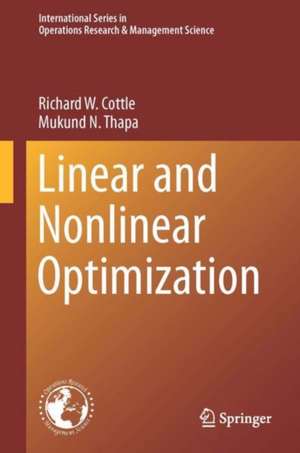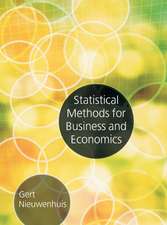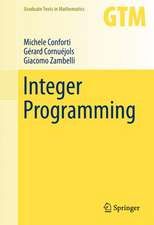Linear and Nonlinear Optimization: International Series in Operations Research & Management Science, cartea 253
Autor Richard W. Cottle, Mukund N. Thapaen Limba Engleză Hardback – 12 iun 2017
The book is based on lecture notes the authors have used in numerous optimization courses the authors have taught at StanfordUniversity. It emphasizes modeling and numerical algorithms for optimization with continuous (not integer) variables. The discussion presents the underlying theory without always focusing on formal mathematical proofs (which can be found in cited references). Another feature of this book is its inclusion of cultural and historical matters, most often appearing among the footnotes.
"This book is a real gem. The authors do a masterful job of rigorously presenting all of the relevant theory clearly and concisely while managing to avoid unnecessary tedious mathematical details. This is an ideal book for teaching a one or two semester masters-level course in optimization – it broadly covers linear and nonlinear programming effectively balancing modeling, algorithmic theory, computation, implementation, illuminating historical facts, and numerous interesting examples and exercises. Due to the clarity of the exposition, this book also serves as avaluable reference for self-study."
Professor Ilan Adler,
IEOR Department,
UC Berkeley
"A carefully crafted introduction to the main elements and applications of mathematical optimization. This volume presents the essential concepts of linear and nonlinear programming in an accessible format filled with anecdotes, examples, and exercises that bring the topic to life. The authors plumb their decades of experience in optimization to provide an enriching layer of historical context. Suitable for advanced undergraduates and masters students in management science, operations research, and related fields."Michael P. Friedlander,
IBM Professor of Computer Science,
Professor of Mathematics,
University of British Columbia
IBM Professor of Computer Science,
Professor of Mathematics,
University of British Columbia
| Toate formatele și edițiile | Preț | Express |
|---|---|---|
| Paperback (1) | 657.57 lei 6-8 săpt. | |
| Springer – 12 mai 2018 | 657.57 lei 6-8 săpt. | |
| Hardback (1) | 912.95 lei 6-8 săpt. | |
| Springer – 12 iun 2017 | 912.95 lei 6-8 săpt. |
Din seria International Series in Operations Research & Management Science
- 20%
 Preț: 331.25 lei
Preț: 331.25 lei - 20%
 Preț: 570.61 lei
Preț: 570.61 lei - 18%
 Preț: 1132.02 lei
Preț: 1132.02 lei - 18%
 Preț: 773.72 lei
Preț: 773.72 lei -
 Preț: 170.39 lei
Preț: 170.39 lei - 17%
 Preț: 459.34 lei
Preț: 459.34 lei - 17%
 Preț: 360.47 lei
Preț: 360.47 lei -
 Preț: 263.40 lei
Preț: 263.40 lei - 24%
 Preț: 905.30 lei
Preț: 905.30 lei - 17%
 Preț: 460.08 lei
Preț: 460.08 lei - 17%
 Preț: 459.34 lei
Preț: 459.34 lei - 20%
 Preț: 631.58 lei
Preț: 631.58 lei - 13%
 Preț: 480.00 lei
Preț: 480.00 lei - 18%
 Preț: 738.28 lei
Preț: 738.28 lei - 18%
 Preț: 1225.94 lei
Preț: 1225.94 lei - 18%
 Preț: 948.92 lei
Preț: 948.92 lei - 18%
 Preț: 703.88 lei
Preț: 703.88 lei - 18%
 Preț: 957.44 lei
Preț: 957.44 lei - 15%
 Preț: 651.84 lei
Preț: 651.84 lei - 20%
 Preț: 336.21 lei
Preț: 336.21 lei - 15%
 Preț: 641.03 lei
Preț: 641.03 lei -
 Preț: 404.29 lei
Preț: 404.29 lei - 18%
 Preț: 950.21 lei
Preț: 950.21 lei - 15%
 Preț: 649.06 lei
Preț: 649.06 lei - 18%
 Preț: 725.75 lei
Preț: 725.75 lei -
 Preț: 394.12 lei
Preț: 394.12 lei - 18%
 Preț: 951.47 lei
Preț: 951.47 lei - 15%
 Preț: 639.59 lei
Preț: 639.59 lei - 18%
 Preț: 773.06 lei
Preț: 773.06 lei - 18%
 Preț: 889.29 lei
Preț: 889.29 lei - 15%
 Preț: 655.60 lei
Preț: 655.60 lei - 15%
 Preț: 640.06 lei
Preț: 640.06 lei - 15%
 Preț: 583.93 lei
Preț: 583.93 lei
Preț: 912.95 lei
Preț vechi: 1113.36 lei
-18% Nou
Puncte Express: 1369
Preț estimativ în valută:
174.69€ • 182.39$ • 144.58£
174.69€ • 182.39$ • 144.58£
Carte tipărită la comandă
Livrare economică 05-19 aprilie
Preluare comenzi: 021 569.72.76
Specificații
ISBN-13: 9781493970537
ISBN-10: 1493970534
Pagini: 614
Ilustrații: XXXI, 614 p. 58 illus.
Dimensiuni: 155 x 235 x 42 mm
Greutate: 1.08 kg
Ediția:1st ed. 2017
Editura: Springer
Colecția Springer
Seria International Series in Operations Research & Management Science
Locul publicării:New York, NY, United States
ISBN-10: 1493970534
Pagini: 614
Ilustrații: XXXI, 614 p. 58 illus.
Dimensiuni: 155 x 235 x 42 mm
Greutate: 1.08 kg
Ediția:1st ed. 2017
Editura: Springer
Colecția Springer
Seria International Series in Operations Research & Management Science
Locul publicării:New York, NY, United States
Cuprins
Chapter 1. LP Models and Applications.- Chapter 2. Linear Equations and Inequalities.- Chapter 3. The Simplex Algorithm.- Chapter 4. The Simplex Algorithm Continued.- Chapter 5. Duality and the Dual Simplex Algorithm.- Chapter 6. Postoptimality Analysis.- Chapter 7. Some Computational Considerations.- Chapter 8. NLP Models and Applications.- Chapter 9. Unconstrained Optimization.- Chapter 10. Descent Methods.- Chapter 11. Optimality Conditions.- Chapter 12. Problems with Linear Constraints.- Chapter 13. Problems with Nonlinear Constraints.- Chapter 14. Interior-Point Methods.
Recenzii
“The historical notes in the book are interesting and well placed. … The book’s list of important references is quite complete. … this book is destined to become a classic in the field for beginning graduate students in optimization.” (S. Zlobec, Mathematical Reviews, January, 2018)
Notă biografică
Richard W. Cottle is a Professor Emeritus from the Department of Management Science and Engineering at Stanford University. He received the degrees of A.B. and A.M. from Harvard University and the Ph.D. from the University of California at Berkeley, all three in mathematics. Under the supervision of George B. Dantzig, Cottle wrote a dissertation in which the linear and nonlinear complementarity problems were introduced. Upon completion of his doctoral studies in Berkeley, Cottle became a member of the technical staff of Bell Telephone Laboratories in Holmdel, New Jersey. Two years later, he joined the operations research faculty at Stanford University where he remained until his retirement in 2005.
For nearly 40 years at Stanford, Cottle taught at the undergraduate, master's, and doctoral levels in a variety of optimization courses including linear and nonlinear programming, complementarity and equilibrium programming, and matrix theory. (The present volume is an outgrowth of one such course.) Most of Cottle's research lies within these fields.
A former Editor-in-Chief of the journals Mathematical Programming and Mathematical Programming Study, Richard Cottle is well known for The Linear Complementarity Problem, a Lanchester Prize winning monograph he co-authored with two of his former doctoral students, Jong-Shi Pang and Richard E. Stone. In retirement he remains active in research and writing.
Mukund N. Thapa is the President & CEO of Optical Fusion, Inc., and President of Stanford Business Software, Inc. He received a bachelor of technology degree in metallurgical engineering from the Indian Institute of Technology, Bombay. His Bachelor's thesis was on operations research techniques in iron and steel making. Later he obtained M.S. and Ph.D. degrees in operations research from Stanford University in 1981. His Ph.D. thesis was concerned with developing specialized algorithms for solving largescale unconstrained nonlinear minimization problems. By profession he is a software developer who produces commercial software products as well as commercial-quality custom software. Since 1978, Dr. Thapa has been applying the theory of operations research, statistics, and computer science to develop efficient, practical, and usable solutions to a variety of problems.
At Optical Fusion, Inc., Dr. Thapa architected the development of a multi-point videoconferencing system for use over all IP-based networks. He holds several patents in the area. The feature-rich system focuses primarily on the needs of users and allows corporate users to seamlessly integrate conferencing
in everyday business interactions. At Stanford Business Software, Dr. Thapa, ensured that the company produces high-quality turnkey software for clients. His expert knowledge of user friendly interfaces, databases, computer science, and modular software design plays an important role in making the software practical and robust. His specialty is the application of numerical analysis methodology to solve mathematical optimization problems. An experienced modeler, he is often asked by clients to consult, prepare analyses, and to write position papers.
At the Department of Management Science and Engineering, Stanford University, Dr. Thapa has taught graduate-level courses in mathematical programming computation and numerical methods of linear programming. He is best known for his books with George B. Dantzig: Linear Programming 1: Introduction and Linear Programming 2: Theory and Extensions.
Textul de pe ultima copertă
This textbook on Linear and Nonlinear Optimization is intended for graduate and advanced undergraduate students in operations research and related fields. It is both literate and mathematically strong, yet requires no prior course in optimization. As suggested by its title, the book is divided into two parts covering in their individual chapters LP Models and Applications; Linear Equations and Inequalities; The Simplex Algorithm; Simplex Algorithm Continued; Duality and the Dual Simplex Algorithm; Postoptimality Analyses; Computational Considerations; Nonlinear (NLP) Models and Applications; Unconstrained Optimization; Descent Methods; Optimality Conditions; Problems with Linear Constraints; Problems with Nonlinear Constraints; Interior-Point Methods; and an Appendix covering Mathematical Concepts. Each chapter ends with a set of exercises.
The book is based on lecture notes the authors have used in numerous optimization courses the authors have taught at StanfordUniversity. It emphasizes modeling and numerical algorithms for optimization with continuous (not integer) variables. The discussion presents the underlying theory without always focusing on formal mathematical proofs (which can be found in cited references). Another feature of this book is its inclusion of cultural and historical matters, most often appearing among the footnotes.
Professor Ilan Adler,
IEOR Department,
UC Berkeley
The book is based on lecture notes the authors have used in numerous optimization courses the authors have taught at StanfordUniversity. It emphasizes modeling and numerical algorithms for optimization with continuous (not integer) variables. The discussion presents the underlying theory without always focusing on formal mathematical proofs (which can be found in cited references). Another feature of this book is its inclusion of cultural and historical matters, most often appearing among the footnotes.
"This book is a real gem. The authors do a masterful job of rigorously presenting all of the relevant theory clearly and concisely while managing to avoid unnecessary tedious mathematical details. This is an ideal book for teaching a one or two semester masters-level course in optimization – it broadly covers linear and nonlinear programming effectively balancing modeling, algorithmic theory, computation, implementation, illuminating historical facts, and numerous interesting examples and exercises. Due to the clarity of the exposition, this book also serves as a valuable reference for self-study."
Professor Ilan Adler,
IEOR Department,
UC Berkeley
"A carefully crafted introduction to the main elements and applications of mathematical optimization. This volume presents the essential concepts of linear and nonlinear programming in an accessible format filled with anecdotes, examples, and exercises that bring the topic to life. The authors plumb their decades of experience in optimization to provide an enriching layer of historical context. Suitable for advanced undergraduates and masters students in management science, operations research, and related fields."Michael P. Friedlander,
IBM Professor of Computer Science,
Professor of Mathematics,
University of British Columbia
IBM Professor of Computer Science,
Professor of Mathematics,
University of British Columbia
Caracteristici
Entirely readable yet mathematically rigorous Includes end-of-chapter exercises Authors are prominent scholars in the field Includes supplementary material: sn.pub/extras













